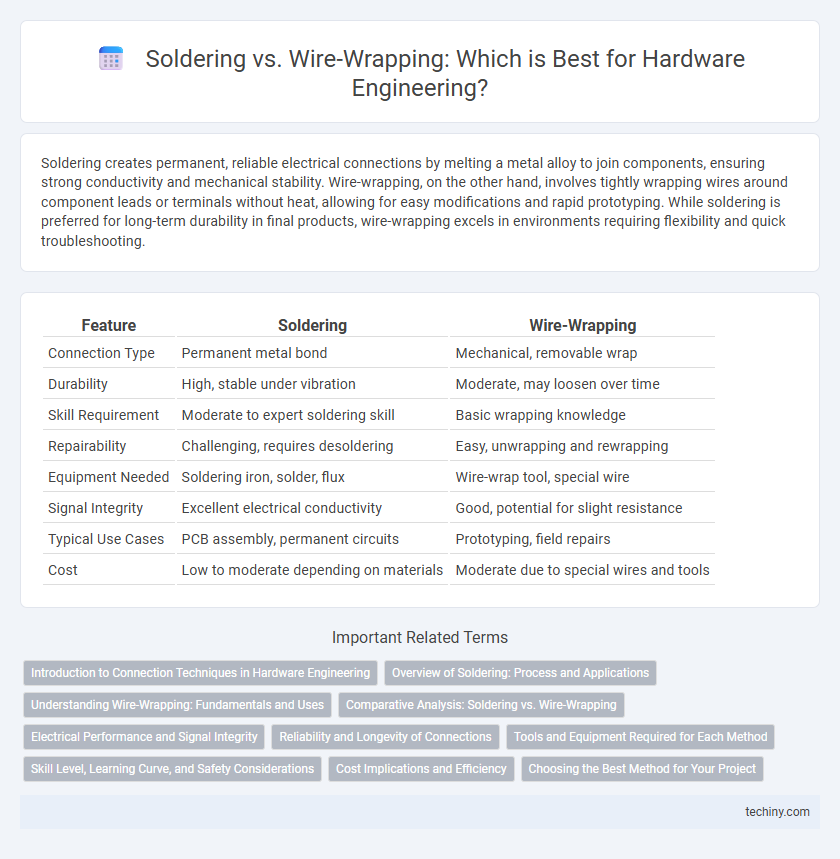Soldering creates permanent, reliable electrical connections by melting a metal alloy to join components, ensuring strong conductivity and mechanical stability. Wire-wrapping, on the other hand, involves tightly wrapping wires around component leads or terminals without heat, allowing for easy modifications and rapid prototyping. While soldering is preferred for long-term durability in final products, wire-wrapping excels in environments requiring flexibility and quick troubleshooting.
Table of Comparison
| Feature | Soldering | Wire-Wrapping |
|---|---|---|
| Connection Type | Permanent metal bond | Mechanical, removable wrap |
| Durability | High, stable under vibration | Moderate, may loosen over time |
| Skill Requirement | Moderate to expert soldering skill | Basic wrapping knowledge |
| Repairability | Challenging, requires desoldering | Easy, unwrapping and rewrapping |
| Equipment Needed | Soldering iron, solder, flux | Wire-wrap tool, special wire |
| Signal Integrity | Excellent electrical conductivity | Good, potential for slight resistance |
| Typical Use Cases | PCB assembly, permanent circuits | Prototyping, field repairs |
| Cost | Low to moderate depending on materials | Moderate due to special wires and tools |
Introduction to Connection Techniques in Hardware Engineering
Soldering involves melting a metal alloy to create a permanent electrical connection between components, offering strong mechanical bonds and excellent conductivity widely used in circuit board assembly. Wire-wrapping uses tightly wound thin wire around a post to establish a reliable, cold-connection method that enables easy modifications and repairs without heat, ideal for prototyping and testing. Both techniques are fundamental in hardware engineering, where choosing between soldering and wire-wrapping depends on factors like durability, rework requirements, and application environment.
Overview of Soldering: Process and Applications
Soldering is a metal-joining process that uses a filler metal with a lower melting point to create a strong, conductive bond between electronic components and circuit boards. Commonly applied in printed circuit board (PCB) assembly, soldering ensures reliable electrical connections essential for complex hardware systems. This technique supports various applications, from prototyping to mass production, due to its durability and efficient thermal conductivity.
Understanding Wire-Wrapping: Fundamentals and Uses
Wire-wrapping is a hardware engineering technique that involves tightly coiling a thin wire around a square post to form a gas-tight, reliable electrical connection without soldering. This method provides advantages such as easy modifications, high signal integrity, and reduced risk of thermal damage to components, making it ideal for prototyping and circuit debugging. Unlike soldering, wire-wrapping simplifies assembly and rework in complex electronic systems, enhancing overall manufacturing efficiency.
Comparative Analysis: Soldering vs. Wire-Wrapping
Soldering offers permanent electrical connections with superior conductivity and mechanical strength, widely preferred for high-density and high-vibration environments. Wire-wrapping provides a reliable, solderless alternative enabling easy component replacement and modifications without heat damage risk, ideal for prototyping and low-volume production. Both methods differ significantly in assembly time, durability, and repairability, influencing their suitability based on project complexity and longevity requirements.
Electrical Performance and Signal Integrity
Soldering provides superior electrical performance and signal integrity due to low-resistance, permanent metallic bonds that minimize signal loss and electromagnetic interference. Wire-wrapping can introduce variable contact resistance and higher susceptibility to signal degradation, especially at high frequencies or in complex circuits. High-frequency signal circuits benefit significantly from soldered connections ensuring stable impedance and reduced crosstalk.
Reliability and Longevity of Connections
Soldering creates strong, permanent joints by melting solder around the wire and pad, ensuring high conductivity and resistance to mechanical stress, which significantly enhances connection reliability and longevity. Wire-wrapping, although easier to modify, relies on mechanical pressure rather than metallurgical bonding, making it more susceptible to corrosion and loosening over time, thus reducing long-term durability. Industrial applications demanding robust, enduring connections frequently prefer soldering for its proven performance under thermal cycling and vibration conditions.
Tools and Equipment Required for Each Method
Soldering requires a soldering iron, solder wire, flux, and often a heat-resistant work surface to create permanent electrical connections. Wire-wrapping utilizes a specialized wire-wrap tool and pre-insulated wire to mechanically secure connections without solder. The soldering process demands precise temperature control tools, while wire-wrapping relies on crimping equipment and wire gauges for reliable, detachable joints.
Skill Level, Learning Curve, and Safety Considerations
Soldering demands a moderate to high skill level with a steeper learning curve due to precision and temperature control requirements, while wire-wrapping is generally easier to master for beginners with minimal training. Soldering carries inherent safety risks such as burns and inhalation of fumes, necessitating proper ventilation and protective equipment, whereas wire-wrapping poses fewer safety hazards but requires careful handling of bare wires to prevent short circuits. Mastery in soldering enhances reliability in permanent connections, contrasting with wire-wrapping's advantage in quick, reversible prototyping with reduced safety concerns.
Cost Implications and Efficiency
Soldering offers lower long-term costs due to durable connections and reduced rework, making it ideal for mass production in hardware engineering. Wire-wrapping, while requiring less specialized equipment initially, often leads to higher labor costs and potential reliability issues, impacting overall efficiency. Choosing soldering improves assembly speed and minimizes maintenance expenses, optimizing both cost and operational efficiency.
Choosing the Best Method for Your Project
Choosing the best method between soldering and wire-wrapping depends on the project's requirements for durability, precision, and repairability. Soldering provides strong, permanent electrical connections ideal for high-performance PCBs and long-term stability, while wire-wrapping offers quick, easily modifiable connections suitable for prototyping and low-voltage applications. Evaluating factors such as circuit complexity, environmental conditions, and expected maintenance ensures the optimal hardware assembly technique.
soldering vs wire-wrapping Infographic

 techiny.com
techiny.com